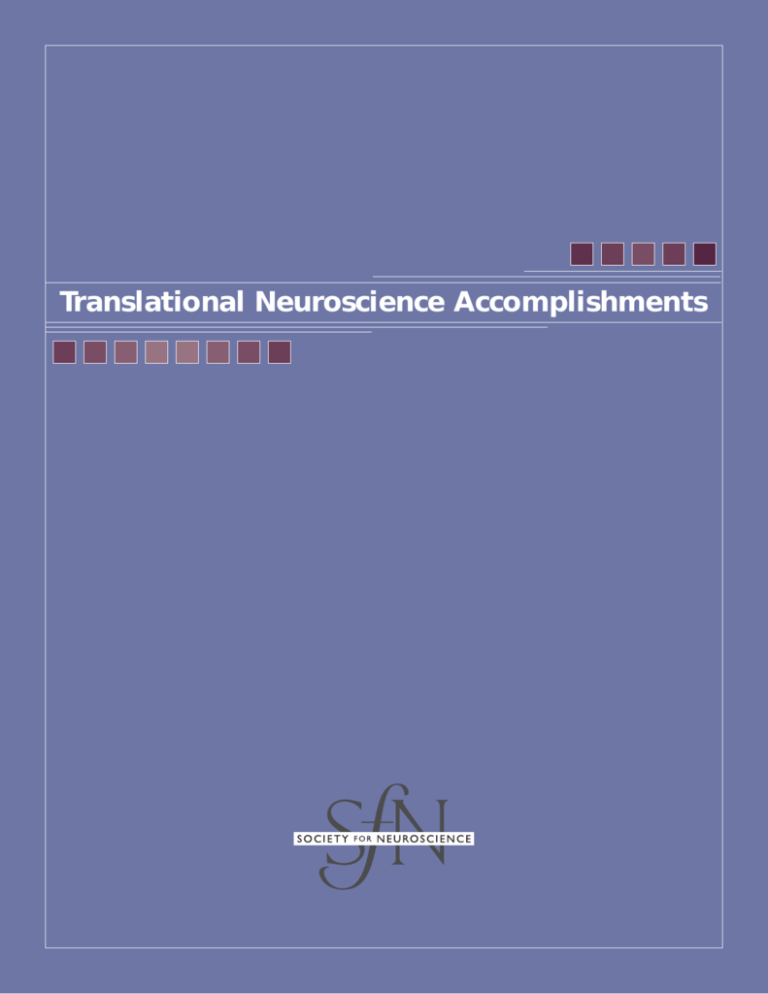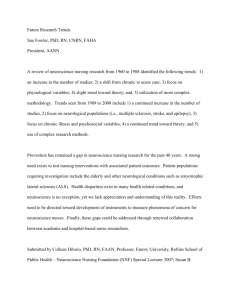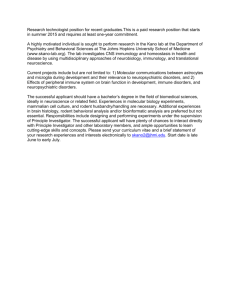Translational Neuroscience Accomplishments
advertisement

Translational Neuroscience Accomplishments Translational Neuroscience Accomplishments The Society for Neuroscience gratefully acknowledges the efforts of the following SfN members in the development of this publication: Committee on Animals in Research David G. Amaral, PhD, Chair Richard K. Nakamura, PhD John Morrison, PhD Michael D. Oberdorfer, PhD Steven W. Barger, PhD Jeffrey A. Roberts, DVM Judy L. Cameron, PhD Margaret D. Snyder, PhD Linda Cork, DMV, PhD Yvette Tache, PhD Suzanne Haber, PhD Anthony J. Wynshaw-Boris, MD, PhD David H. Hubel, MD Translational Neuroscience Accomplishments Subcommittee John Morrison, PhD, Chair Mahlon DeLong, MD Amy Arnsten, PhD John Dowling, PhD Flint Beal, MD Suzanne Haber, PhD Floyd Bloom, MD Mort Mishkin, PhD Dennis Choi, MD, PhD Adrian Morrison, DMV, PhD Linda Cork, DMV, PhD Copyright © 2003, Society for Neuroscience i Translational Neuroscience Accomplishments Table of Contents Impact of Animal Research on the Understanding and Treatment of Human Brain Disorders . . . . . . . . . . . . . . . . . . . . . . . . . . . . . . . . . . . . . . . . . . . . . . . . . . . . . . . 1 The Brain’s Chemical Code . . . . . . . . . . . . . . . . . . . . . . . . . . . . . . . . . . . . . . . . . . . . . . 1 Polio . . . . . . . . . . . . . . . . . . . . . . . . . . . . . . . . . . . . . . . . . . . . . . . . . . . . . . . . . . . . . . . . 1 Prions - Itching Sheep, Mad Cows, and the Laughing Death . . . . . . . . . . . . . . . . . . . . 2 Brain Development and Vision . . . . . . . . . . . . . . . . . . . . . . . . . . . . . . . . . . . . . . . . . . . 3 The Neural Circuitry of Memory . . . . . . . . . . . . . . . . . . . . . . . . . . . . . . . . . . . . . . . . . . 3 Blindness and the Retina . . . . . . . . . . . . . . . . . . . . . . . . . . . . . . . . . . . . . . . . . . . . . . . . 4 Parkinson’s Disease (PD) . . . . . . . . . . . . . . . . . . . . . . . . . . . . . . . . . . . . . . . . . . . . . . . . 4 Multiple Sclerosis . . . . . . . . . . . . . . . . . . . . . . . . . . . . . . . . . . . . . . . . . . . . . . . . . . . . . . 5 Stroke . . . . . . . . . . . . . . . . . . . . . . . . . . . . . . . . . . . . . . . . . . . . . . . . . . . . . . . . . . . . . . . 5 Stress . . . . . . . . . . . . . . . . . . . . . . . . . . . . . . . . . . . . . . . . . . . . . . . . . . . . . . . . . . . . . . . . 6 Depression, Bipolar Disorder, and Schizophrenia . . . . . . . . . . . . . . . . . . . . . . . . . . . . . 7 Drug Addiction . . . . . . . . . . . . . . . . . . . . . . . . . . . . . . . . . . . . . . . . . . . . . . . . . . . . . . . . 8 ii Translational Neuroscience Accomplishments Impact of Animal Research on the Understanding and Treatment of Human Brain Disorders Basic neuroscience research on animal models is essential to understand the nature of brain disorders that afflict humans and develop successful therapies. Several examples of translational neuroscience follow. Some of these examples have already had dramatic impact on human health, while others are at a critical stage of transition, with major clinical impact likely in the very near future. The Brain’s Chemical Code In the mid-’60s, a Swedish team succeeded in visualizing the neural circuits in rodent brains that contained and utilized the neurotransmitters dopamine and norepinephrine. This was quickly followed by the development of other methods (e.g., the use of antibodies) that allowed neuroscientists to link hundreds of important synaptic molecules to identified neural circuits in rodent and nonhuman primate brains, coordinating neuroanatomy, neuropharmacology, and neurophysiology into a cohesive view of biochemically coded brain circuitry. These techniques were also carried back to the analysis of the human brain, often elucidating the biochemical and neurotransmitter nature of a circuit affected in disease, such as the demise of the circuits utilizing acetylcholine in Alzheimer’s disease. This bio chemical view of brain circuitry continues to evolve in its complexity, and has focused much of modern neuroscience on synaptic communication between nerve cells as the key level of interaction in the brain; progress in that area was rewarded with the Nobel Prize in 2000. The synapse is the key target of pharmaceutical intervention for a host of brain disorders that are now understood on the level of synaptic circuitry and functional brain organization, allowing for the development and use of drugs that have much greater specificity for the circuits implicated in multiple psychiatric disorders (e.g., schizophrenia, depression, and attention deficit hyperactivity disorder), as well as neurodegenerative disorders, such as Alzheimer’s disease, amyotrophic lateral sclerosis (ALS), and Parkinson’s disease. Polio Polio is a paralyzing and potentially fatal disease, caused by a viral infection that destroys the nerve cells in the spinal cord and brain that control movement and breathing. This 1 Translational Neuroscience Accomplishments devastating disease, which primarily attacks children, has been eradicated from the Americas through the development and widespread use of the Salk and Sabin vaccines. Animal experimentation, particularly with nonhuman primates, was critically important to virtually every phase of the development of the polio vaccines. First, it was demonstrated that polio was an infectious disease caused by a virus. It could be transmitted to monkeys (but not rabbits, guinea pigs, and mice) by the injection of filtered homogenates of human spinal cord from a patient who died from polio. Nobel Prize-winning work on the polio virus followed, leading to a purified form of the virus that could be grown and manipulated in animal tissues. This Nobel Prize was awarded in 1954. Critically important experiments in monkeys demonstrated that there were actually three strains of the virus, and a successful vaccine would have to create immunity to all three. It was also shown in monkeys that the virus initially resided in the intestines and then circulated through the bloodstream before infecting nerve cells, suggesting that a vaccine could neutralize the virus before its devastating attack on the spinal cord and brain. These experiments set the stage for the successful development and testing of a polio vaccine in nonhuman primates, paving the way for successful vaccines for humans, which are highly effective in preventing this devastating neurological disorder. Prions - Itching Sheep, Mad Cows, and the Laughing Death Scrapie, a fatal disease of sheep, has been known for more than three hundred years. In the early 1900s, animal experiments showed that it was an infectious disease. When a new, fatal human disease, kuru, was identified in the late ‘50s, researchers recognized that kuru’s effect on the brain was similar to that of scrapie, and animal experiments showed it was also infectious like scrapie. Similarly, animal experiments showed that Creutzfeldt-Jakob disease (CJD), a distinct disorder, but with similar changes in the brain, was infectious like both kuru and scrapie. In the ‘80s a devastating infectious disease, “mad cow” disease, appeared in cattle in Britain and other countries. Following the outbreak of mad cow disease, a new type of CJD appeared in humans. Animal experiments showed that the agent that caused this new variant CJD was similar to that of mad cow disease. All of these prion diseases, including scrapie and kuru, are infectious. Detailed animal experiments in rodents and other species have shown that these diseases can be transmitted before the animal shows signs of the disease. Experiments in mice and studies of humans indicate that genetics may play a 2 Translational Neuroscience Accomplishments role in an individual’s susceptibility to some prion diseases. The discovery and characterization of prions and their relevance to neurodegeneration was recognized with the Nobel Prize in 1997. The research on prions provides researchers with a basis to improve the diagnosis and, eventually, the treatment of prion-related disorders in animals and humans. Brain Development and Vision Visual function is dependent on the appropriate formation of precise brain circuits during early development. The visual system of nonhuman primates is highly similar to that of humans, providing an ideal animal model for the study of vision and the development of this system. Animal experiments on nonhuman primates demonstrated that a critical period exists for the few months after birth, during which time the visual pathways in the brain are forming but remain “plastic.” The development of circuits that can see properly for the rest of the animal’s life is highly dependent on the visual input to the system during this period. As the critical period comes to an end, the circuits are no longer plastic and cannot be modified. This insight profoundly affects how neonatal visual defects are diagnosed and treated in humans. For example, children are often born with a condition called strabismus, where the eyes do not work in concert, often due to faulty control of the eye muscles. Before these animal experiments, surgical treatment of strabismus was almost always done at age 6 or older. The animal work makes it clear that the operation has to be done early, before the close of the critical period in order to effectively rehabilitate a child’s vision. This discovery led to a method of preventing several of the most common causes of vision problems in humans, and was recognized for its impact with the Nobel Prize in 1981. The Neural Circuitry of Memory Memory is perhaps the best example in neuroscience of circular translation from neuropsychological observations in humans to detailed studies in animals that now provide a basis for analysis and treatment of memory defects in humans. Careful neuropsychological analysis of a patient who had surgical ablation of part of the temporal lobe for treatment of intractable seizures demonstrated that memory is a unique capacity separable from other cognitive functions, focusing the neuroscience community on the hippocampus and related areas as the critical structures for memory. This led to detailed analyses of both rodent and nonhuman primate models that have elucidated in great detail the neural circuits, synaptic 3 Translational Neuroscience Accomplishments neurobiology, and molecular biology that underlie memory. This detailed understanding of memory would not have been possible without animal studies, yet the information derived from these studies is critically important for addressing disorders like Alzheimer’s disease. Our knowledge of the molecular biology and circuitry of memory has allowed us to develop and test numerous models of the molecular mechanisms that are thought to cause degeneration of the circuits responsible for memory in humans with Alzheimer’s. These mouse models have led to the development of a number of therapeutic strategies, and are now regarded as an essential preclinical stage of drug development aimed at protecting or restoring memory function prior to going into human clinical trials. Blindness and the Retina Retinitis pigmentosa (RP), an inherited form of retinal degeneration, occurs typically in the late teens and causes complete blindness by age sixty. RP is caused by defective genes that result in damaged photoreceptors in the eye. A severe form of RP, called Leber congenital amaurosis (LCA), causes almost complete blindness in human infants. A strain of dogs possesses the same genetic defect as in LCA, which prevents the photoreceptors from synthesizing visual pigment molecules. Recent gene therapy experiments inserted the correct gene next to the photoreceptors, restoring vision in these dogs. Clearly, while the knowledge gained via these experiments provide a hope and basis for humans afflicted with LCA, the dogs, in which this genetic defect is endemic, also benefited from the experiments. Parkinson’s Disease (PD) Parkinson’s disease (PD) is characterized by lowered levels of dopamine in the basal ganglia, which is caused by degeneration of the neurons that provide this circuit. Animal research in rodents has resulted in major advances in scientific understanding of the underlying mechanisms of neurodegeneration and how to potentially reverse this process. Animal research in nonhuman primates is also essential to understand and treat PD. The use of a drug called MPTP in these models simulates PD by selectively causing degeneration of certain dopamine neurons, similar to that found in PD patients. Use of these models allowed researchers to learn that cell death from lowered dopamine levels in the basal ganglia causes increased firing patterns of neurons in the subthalamic nucleus (STN) and globus pallidus. That knowledge has led to two treatments. First, lesions were used to ameliorate Parkinson’s 4 Translational Neuroscience Accomplishments symptoms in the models, either of the STN or the globus pallidus, and then led to surgical approaches to treat PD in humans. Secondly, researchers using the animal models discovered that deep brain stimulation is an even more effective treatment, since it is relatively nondestructive and is reversible or adjustable, according to the needs of the patient. Multiple Sclerosis Rats and mice are crucial models for studying MS, since they can be immunized with myelin, producing a condition that simulates multiple sclerosis. That process is called experimental allergic encephalitis (EAE) and has allowed scientists to identify the various white blood cells, antibodies, and other immune molecules that are responsible for brain injury. EAE also allows scientists to design and test new drugs that can target specific cell types or immune molecules. Because inbred rodents are genetically identical, white blood cells and other cells can be transplanted from one animal to another without being rejected. This means scientists can also use EAE to evaluate experimental techniques such as injecting myelin-forming cells into the brain or spinal cord, or providing stem cells as a means of repairing the damage - even long after the damage has occurred. The use of this animal model has provided basic information about how myelin-forming cells respond to injury, what conditions stimulate them to divide, and what prevents them from repairing myelin loss. The rodent model creates a unique opportunity to observe the way myelin is created, damaged, and repaired, which has been essential in improving treatment for MS. Stroke Neurons cannot usually divide and replace themselves, so the brain cells and functions that are lost in a stroke will be permanent unless other brain cells take over the functions of those that have died. The consequences of stroke can include paralysis, loss of speech, or other disabilities. The use of animal models guided the successful development of the only currently established clinical treatment for stroke, the administration of a drug called tissue plasminogen activator, which relieves clots blocking blood flow to the brain. Scientists have also identified several ways to reduce the damage from strokes as a result of animal research, such as cooling the brain so that tissue damage is reduced and using drugs to reduce the tissue-damaging chemicals released when cells are damaged by oxygen loss. Experimental studies in animals have shown that after a stroke, nerve cells can be encouraged to take over the 5 Translational Neuroscience Accomplishments functions of the neurons that have degenerated. For example, by preventing a monkey from using a normal arm after the other arm is paralyzed due to loss of cortical control, the monkey can be encouraged to learn to use the free, but paralyzed, arm. The attempts to use the paralyzed arm promote surviving nerve cells to assume new functions, and paralysis is diminished. Follow-up studies in human stroke patients have confirmed the benefits of this new approach to rehabilitation. Stress Exposure to chronic, uncontrollable stress can lead to symptoms of depression and/or anxiety, while exposure to even a single traumatic stressor can induce post-traumatic stress disorder (PTSD). Although there is significant individual variation in vulnerability to stress, studies using animal models are identifying genetic sequences that convey a predisposition for mood disorders related to stress. Even the brain’s structure can be altered by stress. For example, imaging studies have shown that certain brain regions appear to be smaller in many PTSD patients. However, basic animal research has revealed the biochemistry and neuroanatomy of stress and how the brain is altered by stress exposure. Higher centers in the brain can detect psychological stressors and orchestrate the stress response through three main brain mechanisms. First, stress causes increased levels of norepinephrine and cortisol to be released from the adrenal gland. Next, these elevated levels enhance the functioning of the amygdala, which is a brain region that orchestrates the fear response, helps us understand the emotional significance of stimuli, and enhances memories of emotionally significant events. However, the increased cortisol can impair the hippocampus, even leading to neuron death. In addition, the high levels of norepinephrine and dopamine impair the functioning of the prefrontal cortex, a higher brain region involved in complex thought that also regulates emotion through its connections with the amygdala. Recent animal research shows that one function of the prefrontal cortex may be to block repeated fear responses to the same stimulus, thus impairment in this region might explain why people with PTSD experience their fear over and over again. Animal studies have shown that drugs which alter norepinephrine’s actions can diminish the functions of the amygdala and enhance those of the prefrontal cortex, re-establishing the appropriate balance between these brain regions. Based on this animal research, norepinephrine-based drugs are now being used to treat patients with PTSD. Even the stress-induced neuron death and shrinkage in brain regions such as the hippocampus may be treatable. Very recent animal research suggests that 6 Translational Neuroscience Accomplishments medications that increase serotonin levels in the brain can even increase the production of new cells in the hippocampus. Serotonin-based drugs are also currently used to treat PTSD patients, and may be useful in preventing PTSD from progressing and damaging neurons in the hippocampus. Depression, Bipolar Disorder, and Schizophrenia The successful treatment of depression depends on creating animal models and using those to understand the disorder and develop appropriate medicines. Administering the drug reserpine causes the depletion of the monoamines serotonin, norepinephrine, and dopamine in the brain, creating depressive-like behavior in animals. The depressed behavior of the animals was reversed by restoring brain norepinehrine and/or dopamine levels, relating monoamines to mood and reward as well as the proper functioning of higher brain regions that regulate emotion and thought. The great success of recent antidepressant medications such as Prozac has evolved from animal research, which has resulted in a better understanding of the brain mechanisms contributing to depression. Animal research is also crucial in developing treatments for bipolar disorder. Research on guinea pigs led to the discovery that lithium acts as a mood stabilizer for mania in animals. Lithium was shown to be a successful treatment in human patients, and is now used to treat mania and bipolar (manic-depressive) disorder. Genetic alterations in patients with bipolar disorder may disrupt signals inside of brain cells. Animal research suggests lithium may normalize these signals. Since lithium can be toxic at higher doses, animal studies are in progress to help develop medications with fewer side effects. The first widely used medications for schizophrenia became available in the ‘50s and ‘60s. However, these medications caused debilitating side effects and were only effective for roughly half of all patients with this illness. Based on animal research, in which the brain’s dopamine and serotonin pathways were better explored, the last 10 years have seen the introduction of several antischizophrenic medications that are safer and more effective than the older drugs. Together, these advances in the pharmacologic treatment of mental disorders continues to restore millions of people to healthy, productive lives, and further reduces the financial burden of mental illness on our society. 7 Translational Neuroscience Accomplishments Drug Addiction Drug addiction, which is often fatal, is characterized by compulsive drug seeking and use, despite severely negative consequences. Research using rats showed that normal animals, when given access to certain drugs of abuse, will continue to self-administer these drugs compulsively. Other studies showed that rodents will do work in order to activate electrodes implanted in specific brain regions associated with reward (self-stimulation). This reward pathway consists of neural connections between the ventral tegmental area and the nucleus accumbens, and contains the monoamine neurotransmitters associated with mood. Drugs act in the brain by increasing the transmission of monoamines or other neurotransmitters in the reward pathway, which has a reinforcing effect on the addictive behavior. After understanding the biological underpinnings of addiction, researchers were able to use animal models to devise a treatment using the drug naloxone. Naloxone acts to block the drug effects of opioids, such as heroin, by blocking receptors in the brain. This treatment can be used in cases of respiratory depression in addicted infants and overdose, to reverse some of the harmful effects of heroin. Animal research has also demonstrated how signaling within a neuron is altered with drugs of abuse, which has been connected to the compulsive and uncontrollable nature of addiction. These advances in our understanding of addiction are leading to the development of fundamental new treatments for addictive disorders. These treatments are now in clinical testing. 8





